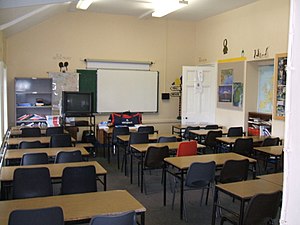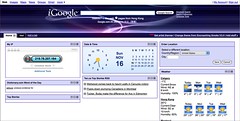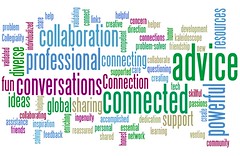One thing that I want to say is WOW. I have gained so many resources and so much knowledge over the past 2 months. To start I now understand that I am a digital immigrant and that my kids and the children I teach are digital natives.
 Image by Meer via Flickr
Image by Meer via Flickr
It will always be a bit more difficult for me to learn and use technology the way they do. But this is a challenge I embrace.
Having developed my PLN (see prior post), I now have the ability to keep up with and learn new resources. Just today I read about online binders posted on the Free Technology for Teachers Blog. So not only have a learned new tools, but I have learned how to learn on my own. That is the most vital thing we can teach our students; to teach themselves. Check out the 100 Best Blogs for Teachers.
One of the most important things I have learned in this course (this is one of my first courses towards a Masters of Education) is how to find and read the GLEs online. Obviously it is critical to know what you are expected to teach in order to be an effective certified teacher. In addition, I love the wiki on Bloom’s Taxonomy that Professor Chamberlain showed us. This has really helped me get my hands around the concept of higher order thinking. I plan to use these websites continuously until the information gets embedded in my brain.
 Image via Wikipedia
Image via Wikipedia
Voicethread for digit story telling. I think that digit story telling is a valuable tool for all ages. It is so simple, yet opens a world of creativity.
Podcasting using Audacity and maybe using music from Garageband. I will remember to have students create fictional characters to protect their identities. I think this is a fun way to study weather and numerous other subjects by asking students to be reporters.
Video Conferencing using Skype or possibly Flash Meeting. This is a fantastic way to invite guest speakers that would not ordinarily be able to travel to the classroom.
Webquests using goggle sites. I love being able to define the way the students will use the Internet throughout their study or project. By defining the links the students can use we can make sure we have looked at the 5 w’s of website evaluation. This alleviates our fears of students navigating to inappropriate sites while researching. Perfect.
 Image by Matrixizationized via Flickr
Image by Matrixizationized via Flickr
Here I have my weather, news (I am still trying to determine which news is the best to read), my calendar on google (linked to my outlook calendar – the google calendar will allow me to incorporate other people’s/activities schedules if necessary), my tasks (I need to write everything down – in fact this blog is going to be a great resource for me to go back to!), Facebook, Twitter, Google Reader (this gives a quick blurb and link to all the blogs and RSS feeds – honestly I can’t possibly read all of it, I have 258 unread blogs right now – but I can scroll through and read the ones that grab my attention and star the ones I know I want to be able to find again). And I have added a vocabulary gadget. I see a new word with definition and picture on every refresh. That has been interesting and fun, but I haven't remembered all the words! The best part of this is I can use any computer to get my stuff! Before I had to use my own laptop to check my calendar and tasks. I have not yet entered the iphone/blackberry stage..although it seems about time...
![Reblog this post [with Zemanta]](http://img.zemanta.com/reblog_e.png?x-id=2febfb2c-4628-4049-8275-788775cf9fa5)

![Reblog this post [with Zemanta]](http://img.zemanta.com/reblog_e.png?x-id=15ff232d-6328-4ad5-85bc-f567ff1baadd)

![Reblog this post [with Zemanta]](http://img.zemanta.com/reblog_e.png?x-id=18db7597-493c-40ab-99fa-ca85d4ada310)

![Reblog this post [with Zemanta]](http://img.zemanta.com/reblog_e.png?x-id=2cc15ee7-afd9-4761-b20e-2c4a9bf9b78e)
